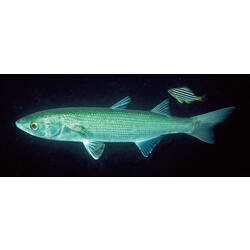General Description
Body elongated and somewhat compressed (narrow from side to side) with a broad head, a short pointed snout and a small mouth. Two short-based dorsal fins and a slightly forked tail. Silvery in colour with a golden-brown to yellowish tinge on the back and a distinctive yellow eye. Body up to 50 cm.
Biology
The Yelloweye Mullet is the most common mullet in southern Australia. Large schools of Yelloweye Mullet are often seen in surface waters along the coast. It feeds on detritus and plankton It is a popular angling fish.
Distribution
Eastern, southern and western Australia.
Habitat
Coastal waters, bays, estuaries, coastal lakes and in the lower freshwater parts of rivers; often around mangroves and over seagrass beds in depths of 0-10 m.
More Information
-
Animal Type
-
Animal SubType
-
Brief Id
Silvery fish with two short-based dorsal fins, a broad head, short pointed snout, slightly forked tail and yellow eyes.
-
Maximum Size
44 cm
-
Habitats
-
Diet
Omnivore
-
Endemicity
-
Commercial
Yes
-
Conservation Statuses
DSE Advisory List: Not listed, EPBC Act 1999: Not listed, IUCN Red List: Not listed
-
Depths
Shore (0-1 m), Shallow (1-30 m)
-
Water Column Locations
Midwater, Surface
-
Taxon Name
-
Scientific Author
(Valenciennes, 1836)
-
Common Name
Yelloweye Mullet
-
Kingdom
-
Phylum
-
Subphylum
-
Superclass
-
Class
-
Order
-
Family
-
Genus
-
Species Name
forsteri




